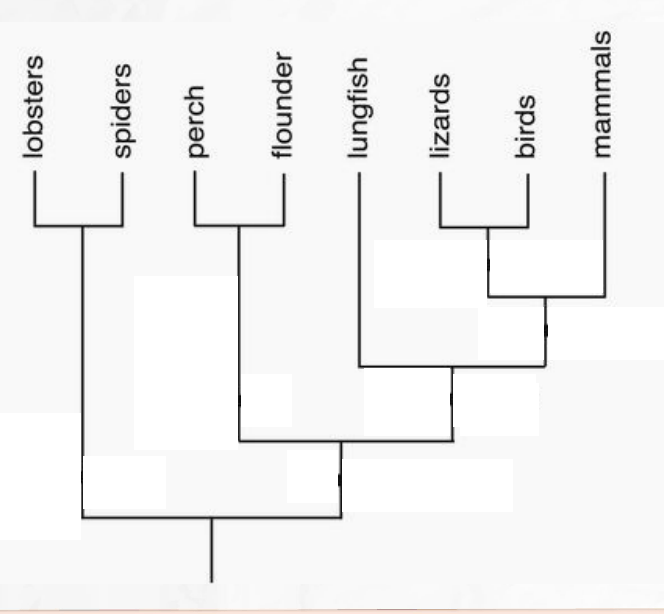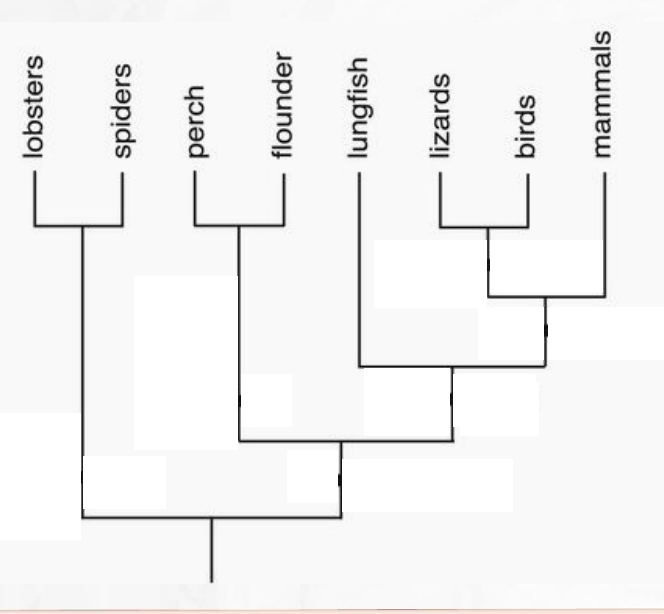A branching diagram that shows evolutionary relationships between species
What is a cladogram or phylogenetic tree
This is any evidence of prehistoric life found in the rock record.
What is a fossil
The image below shows examples of these kinds of structures
What are homologous Structures
The study of where organisms live and how they got there
What is Biogeography
The process by which genetic information is passed on from parent to child, and a CRUCIAL part of Evolution.
What is inheritance
The direction that "time" goes in evolutionary tree diagrams
From the bottom up (bottom is oldest, top is youngest)
With fossils, we are able to ____________ the anatomy of ancient organisms with their modern descendants, tracing back the evolution of traits and characteristics
Compare
Body parts of different species that have a similar function, but evolved independently of each other and are NOT structurally similar
What are analogous structures
The change in frequency of certain traits from one generation to the next
What is microevolution
In evolutionary biology, this describes how well an organism can survive and reproduce in its environment.
What is fitness
An organism where more than one species can trace its ancestry back to
Common ancestor
A type of fossil that shows evidence of behaviors, but not exactly of the organism itself (like footprints or burrows)
What are trace fossils?
This pattern of evolution is when a species evolves into one of more sizes more over time
What is divergent evolution
An imaginary boundary in Australasia that divides where species north of the line are more similar to plants and animals in Asia and those south of the line are more similar to plants and animals in Australia
What is the Wallace Line
The three mechanisms of evolution
What are natural selection, gene flow, and genetic drift
Evolutionary tree diagrams can be created using animal characteristics as well as this other precious source of information.
An organisms' DNA or genetic code
Fossils provide evidence for evolution by showing the changes in the physical traits and characteristics of species over time.
Structures similar in form but not necessarily in function show what style of evolution?
What is divergent evolution?
Explain how small-scale changes in characteristics of a population over a few generations provides evidence of evolution?
These small changes demonstrate the mechanisms of how evolutionary change occurs from parent to offspring. By observing population changes in characteristics over a short period of time, we can imagine how these small changes, after occurring for thousands or millions of years, can lead to big changes like new species.
The organisms Charles Darwin observed in the Galapagos that had specialized body parts better suited for specific environments.
What are finches
On the tree below, mark where hypothetical "common ancestors" are.


The discovery of Tiktaalik, a transitional fossil between fish and tetrapods, provides evidence for which major event in the evolution of life on Earth?
The transition of animals from living in water to on land
How does embryology show evidence of evolution?
Embryology provides evidence of evolution by showing similarities in early developmental stages of different species, suggesting a common ancestry.
How does biogeography provide evidence for evolution?
Biogeography shows patterns of species distribution that are best explained by common ancestry and evolution. For example, if similar animals with related characteristics are found in the same geographic region, it may suggest that they share a common ancestor and evolved over time to adapt to the same environment.
An inherited trait that increases an organism's ability to survive and reproduce in its environment.
What is an adaptation?